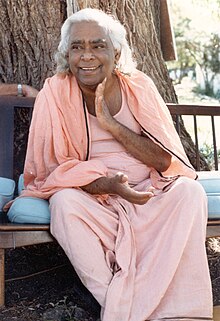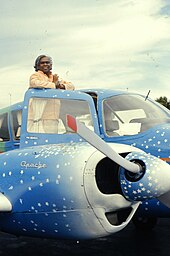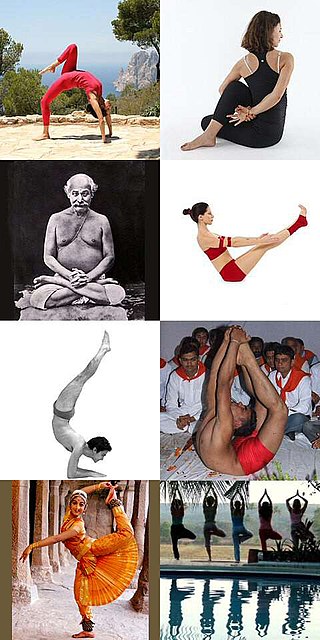
An āsana is a body posture, originally and still a general term for a sitting meditation pose, and later extended in hatha yoga and modern yoga as exercise, to any type of position, adding reclining, standing, inverted, twisting, and balancing poses. The Yoga Sutras of Patanjali define "asana" as "[a position that] is steady and comfortable". Patanjali mentions the ability to sit for extended periods as one of the eight limbs of his system. Asanas are also called yoga poses or yoga postures in English.

Sivananda Saraswati was a yoga guru, a Hindu spiritual teacher, and a proponent of Vedanta. Sivananda was born in Pattamadai, in the Tirunelveli district of Tamil Nadu, and was named Kuppuswami. He studied medicine and served in British Malaya as a physician for several years before taking up monasticism.

Satyananda Saraswati, was a Sanyasi, yoga teacher and guru in both his native India and the West. He was a student of Sivananda Saraswati, the founder of the Divine Life Society, and founded the Bihar School of Yoga in 1964. He wrote over 80 books, including the popular 1969 manual Asana Pranayama Mudra Bandha.

Satchidananda Saraswati, born C. K. Ramaswamy Gounder and usually known as Swami Satchidananda, was an Indian yoga guru and religious teacher, who gained fame and following in the West. He founded his own brand of Integral Yoga, and its spacious Yogaville headquarters in Virginia. He was the author of philosophical and spiritual books and had a core of founding disciples who compiled his translations and updated commentaries on traditional handbooks of yoga such as the Yoga Sutras of Patanjali and the Bhagavad Gita for modern readers.

The Divine Life Society (DLS) is a Hindu spiritual organization and an ashram, founded by Swami Sivananda Saraswati in 1936, at Muni Ki Reti, Rishikesh, India. Today Divine Life Society has branches around the world, with the headquarters situated in Rishikesh. Many disciples of Swami Sivananda have started independent organizations in Mauritius, the United States, Australia, Canada, Malaysia, South Africa, South America, and Europe.

Halasana or Plough pose is an inverted asana in hatha yoga and modern yoga as exercise. Its variations include Karnapidasana with the knees by the ears, and Supta Konasana with the feet wide apart.

Sivananda Yoga is a spiritual yoga system founded by Vishnudevananda; it includes the use of asanas but is not limited to them as in systems of yoga as exercise. He named this system, as well as the international Sivananda Yoga Vedanta Centres organization responsible for propagating its teachings, after his guru, Sivananda with the mission 'to spread the teachings of yoga and the message of world peace' which has since been refined to 'practice and teach the ancient yogic knowledge for health, peace, unity in diversity and self-realization.'

The Complete Illustrated Book of Yoga is a bestselling 1960 book by Swami Vishnudevananda, the founder of the Sivananda Yoga Vedanta Centres. It is an introduction to Hatha yoga, describing the Yoga Sutras of Patanjali and the Hatha Yoga Pradipika. It contributed to the incorporation of Surya Namaskar into yoga as exercise. While some of its subject matter is the traditional philosophy of yoga, its detailed photographs of Vishnudevananda performing the asanas is modern, helping to market the Sivananda yoga brand to a global audience.

Bakasana, and the similar Kakasana are balancing asanas in hatha yoga and modern yoga as exercise. In all variations, these are arm balancing poses in which hands are planted on the floor, shins rest upon upper arms, and feet lift up. The poses are often confused, but traditionally Kakasana has arms bent, Bakasana has the arms straight.

Pranavānanda Saraswati known previously as N. Ponniah was a founding member of the Divine Life Society in Malaysia.
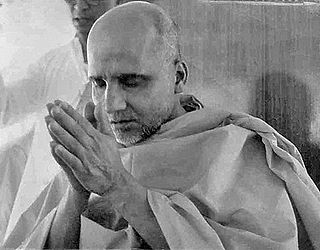
Swami Krishnananda Saraswati was a disciple of Sivananda Saraswati and served as the General Secretary of the Divine Life Society in Rishikesh, India from 1958 until 2001. Author of more than 40 texts, and lecturing extensively, on yoga, religion, and metaphysics, Krishnananda was a prolific theologian, saint, yogi and philosopher.
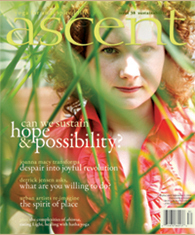
ascent was an independent, not-for-profit magazine published quarterly that explores the intersection of spiritual values with social and political issues, art, culture and contemporary thought. ascent also published a website, a blog, books, and held an annual retreat at Yasodhara Ashram. The tag line for the magazine was "Yoga for an inspired life". Its offices were based in Montreal, Quebec, Canada.

Chidananda Saraswati was president of the Divine Life Society, Rishikesh, India. He is well known in India as a yogi and spiritual leader. He succeeded as president of the Divine Life Society in 1963, after the death of his predecessor, Sivananda Saraswati, who founded the Society.

Sivananda Radha Saraswati, born Sylvia Demitz, was a German yogini who emigrated to Canada and founded Yasodhara Ashram in British Columbia. She established a Western-based lineage in the Sivananda tradition and published books on several branches of Yoga, including Kundalini Yoga for the West and Mantras; Words of Power. She was a member of the California Institute of Transpersonal Psychology and developed transpersonal psychology workshops to help students prepare for intense spiritual practice. Teachers trained at Yasodhara Ashram can now be found across North America and in Europe, the Caribbean, Japan, Australia and New Zealand.

Yoganidrasana, or Yogic Sleep Pose is a reclining forward-bending asana in modern yoga as exercise. It is sometimes called Supta Garbhasana. The name Dvi Pada Sirsasana is given to the balancing form of the pose.

Yoga as exercise is a physical activity consisting mainly of postures, often connected by flowing sequences, sometimes accompanied by breathing exercises, and frequently ending with relaxation lying down or meditation. Yoga in this form has become familiar across the world, especially in the US and Europe. It is derived from medieval Haṭha yoga, which made use of similar postures, but it is generally simply called "yoga". Academics have given yoga as exercise a variety of names, including modern postural yoga and transnational anglophone yoga.

Sexual abuse by yoga gurus is the exploitation of the position of trust occupied by a master of any branch of yoga for personal sexual pleasure. Allegations of such abuse have been made against modern yoga gurus such as Bikram Choudhury, Kausthub Desikachar, Yogi Bhajan, Amrit Desai, and K. Pattabhi Jois. There have been some criminal convictions and lawsuits for civil damages.

The history of yoga in the United States begins in the 19th century, with the philosophers Ralph Waldo Emerson and Henry David Thoreau; Emerson's poem "Brahma" states the Hindu philosophy behind yoga. More widespread interest in yoga can be dated to the Hindu leader Vivekananda's visit from India in 1893; he presented yoga as a spiritual path without postures (asanas), very different from modern yoga as exercise. Two other early figures, however, the women's rights advocate Ida C. Craddock and the businessman and occultist Pierre Bernard, created their own interpretations of yoga, based on tantra and oriented to physical pleasure.

Postural yoga began in India as a variant of traditional yoga, which was a mainly meditational practice; it has spread across the world and returned to the Indian subcontinent in different forms. The ancient Yoga Sutras of Patanjali mention yoga postures, asanas, only briefly, as meditation seats. Medieval Haṭha yoga made use of a small number of asanas alongside other techniques such as pranayama, shatkarmas, and mudras, but it was despised and almost extinct by the start of the 20th century. At that time, the revival of postural yoga was at first driven by Indian nationalism. Advocates such as Yogendra and Kuvalayananda made yoga acceptable in the 1920s, treating it as a medical subject. From the 1930s, the "father of modern yoga" Krishnamacharya developed a vigorous postural yoga, influenced by gymnastics, with transitions (vinyasas) that allowed one pose to flow into the next.
